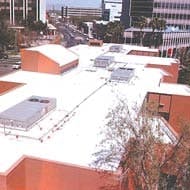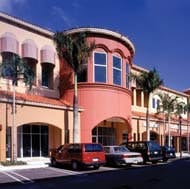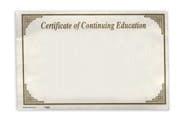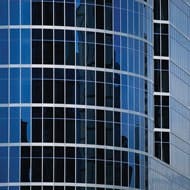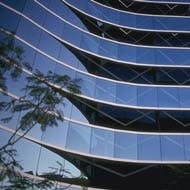100 Influences That Have Shaped the Buildings Market: Page 2
2 of 4
Buildings launches its 100th-anniversary celebration by showcasing some of the commercial and institutional buildings industry’s most momentous happenings - in no specific order - all of which have affected the “business of buildings” throughout the past century. Discover the proven processes, ideas, leaders, events, and landmarks, selected by the editorial staff.
26. The Donald. Up, down, and back on top. Trump exemplifies the power of marketing.
27. ENERGY STAR®. The U.S. Environmental Protection Agency’s ENERGY STAR program has been helping businesses and consumers reduce energy consumption since 1992. What started as a voluntary labeling program for building products has grown to include labeling of commercial and institutional buildings. Additionally, ENERGY STAR provides facilities professionals with information, tools, and best practices to help them achieve their energy management goals. Its predecessor - Green Lights - paved the way by promoting profitable investment in energy-efficient lighting.
28. Single-ply roofing. It’s flexible, easy to install, and involves strict quality control requirements during the manufacturing process. With the invention of single-ply, the need to heat up bitumen vanished. Light-colored, reflective single-ply roofs also offer sustainable elements and can serve as a lightweight solution to accommodate unusual roofing designs.
29. Cell phones, PDAs, and 2-way radios. Communication has never been easier for facilities professionals working in the field and on campuses; they can make a call, text message, or communicate via radio waves and a network of towers and antennas. This technology has made working anytime from anywhere possible (which is, of course, good and bad).
30. The Great Depression.
31. Tilt-up concrete construction. While the first tilt-up building was constructed at the turn of the century, it wasn’t until the 1940s (when the mobile crane and ready-mix concrete were invented) that the construction method really gained popularity. Today, the Mt. Vernon, IA-based Tilt-Up Concrete Association reports that, nationwide, more than 15 percent of all industrial buildings (ranging in size from 5,000 to over 1.5 million square feet) are tilt-up, with design options ranging from utility to funky.
32. Hurricane Andrew. Until Katrina hit in September 2005, Hurricane Andrew (1992) was the most destructive hurricane on record to run aground in the United States. Broken glass resulting from high winds and airborne debris caught the attention of Florida building officials, and Miami-Dade County building codes were strengthened to minimize future damage. Manufacturers responded. Case in point: shatter-resistant window film.
33. Photoluminescent technology. Including a provision mandating photoluminescent markings in buildings 75 feet or taller, New York City’s Local Law 26/04 (enacted recently by the NYC Department of Buildings) demonstrates one city’s attempt to facilitate safe evacuation of building occupants. Buildings in the Big Apple are not alone in their use of photoluminescent technology. Owners and managers nationwide are installing these products near exits and in stairwells.
34. Elevators: from operators to microprocessor controls. It was once necessary to employ a conductor to manage elevator traffic efficiently. While the addition of microprocessor controls may have put those individuals out of work, these more sophisticated systems could now analyze traffic conditions and dispatch elevators as efficiently as possible, delivering the greatest amount of service with the least number of cabs.
35. Gerald D. Hines. In 1957, Gerald Hines opened a one-man office in downtown Houston. Over the next 48 years, his company would develop more than 700 properties, including some of the most skyline-defining examples of architecture. Hines’ developments are known for their innovative solutions. The company was an early adopter of harmonic distortion cancellation transformers, outside air economizers, mold-resistant shaft liners, and underfloor air distribution systems.
36. Professional designations. Industry organizations have responded to the call for more training and education, and have been offering the opportunity for individuals to earn a professional designation since the early 1990s. Professionals keep up and get ahead through the programs offered by IFMA (designations: CFM and FMP), BOMI (designations: RPA, FMA, SMT, and SMA), and IREM (designations: ARM and CPM), among others.
| 38. 9/11 |
39. Earth Day and recycling. The establishment of Earth Day offered an occasion for many facilities management professionals to listen, learn, question, and discuss waste management, environmental standards, and sustainability practices. And as the concept of recycling has caught on across the United States, waste reduction and reuse have become top-of-mind issues as well.
40. The invention of curtainwall. Even though exterior curtainwall doesn’t carry any of a building’s loads, it must support its own weight, resist imposed wind loads, and remain structurally sound throughout its design life. It provides a water barrier, reduces noise levels, and separates the exterior climate from the interior via thermal insulation.
“By the Book”
41. Intl. Building Codes. In an effort to create a single set of building codes, the Building Officials and Code Administrators Intl. Inc. (BOCA), Intl. Conference of Building Officials (ICBO), and Southern Building Codes Congress Intl. Inc. (SBCCI) formed the Intl. Code Council in 1994. By developing a single set of model codes, code enforcement officials, architects, engineers, designers, and contractors can work with a consistent set of requirements throughout the United States. The result of ICC’s work is an inventory of Intl. Codes, the Intl. Building Code being just one example.
42. ASHRAE 90.1. This standard has been reducing energy in buildings since the ’70s. Today, the ASHRAE 90.1 building code continues to encourage the adoption of cost-effective design practices and technologies that minimize energy consumption. Widespread adoption resulted when the Energy Policy Act of 1992 required state and local governments to update their commercial building energy-efficiency codes to meet the ASHRAE 90.1-1989 standard. More recently, the Energy Policy Act of 2005 makes provisions for a tax deduction on new construction projects if annual energy and power costs on select building systems are 50-percent or more below ASHRAE Standard 90.1-2001.
43. NFPA 5000 Building Construction and Safety Code™ and NFPA 101 Life Safety Code®. The National Fire Protection Association has strived to reduce fire incidences and life-safety hazards since its establishment in 1896. The NFPA 5000 and NFPA 101 codes fulfill that objective and seek to protect both life and property.
45. Whole-building design. What building product doesn’t impact another? Savvy facilities and A&D professionals have embraced a holistic philosophy about a space - taking into account the optimal interaction of windows, ceiling, flooring, ductwork, etc. and how they work optimally as a unit.
46. Design/build. According to the Washington, D.C.-based Design-Build Institute, design/build represents a return to the time-honored approach of the master builder. With this process, a single source has complete responsibility for both design and construction; a single point of responsibility ensures quality, cost, and schedule adherence. Fast-track construction is now also possible with design/build: Materials/equipment procurement and construction work can begin before construction documents are fully completed.
48. The creation of IFMA, and the establishment of “facilities management.” Giving facilities management a unified voice with its 18,000 members, IFMA is now the largest and most widely recognized professional association for facility management. The organization certifies facility managers, conducts research, provides educational programs, recognizes facility management degree and certificate programs, and produces World Workplace, the largest facility management-related conference and exposition.
50. Retail entrepreneurs. Americans love to shop - thanks to such retail pioneers as James W. Rouse, who pioneered indoor malls and is often credited with rejuvenating downtown areas in the United States during the 1970s; Melvin Simon, who formed his own company in 1960 and through marketing savvy and acquisitions became the “Landlord of Choice”; and Sam Walton, who took the big-box to broader and more successful interpretation.


